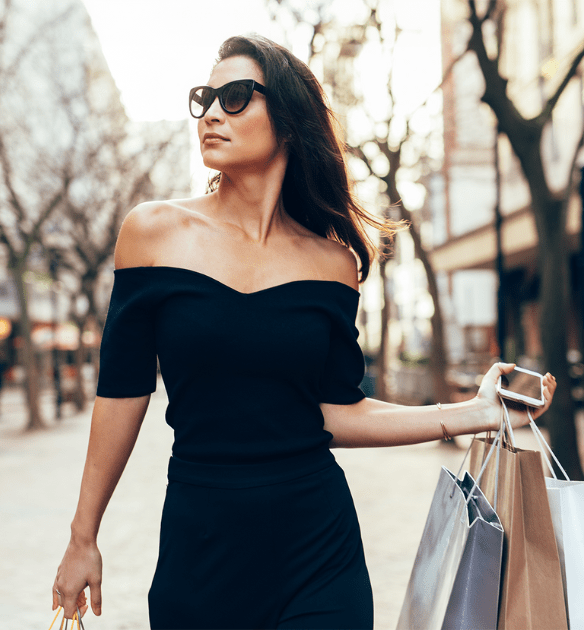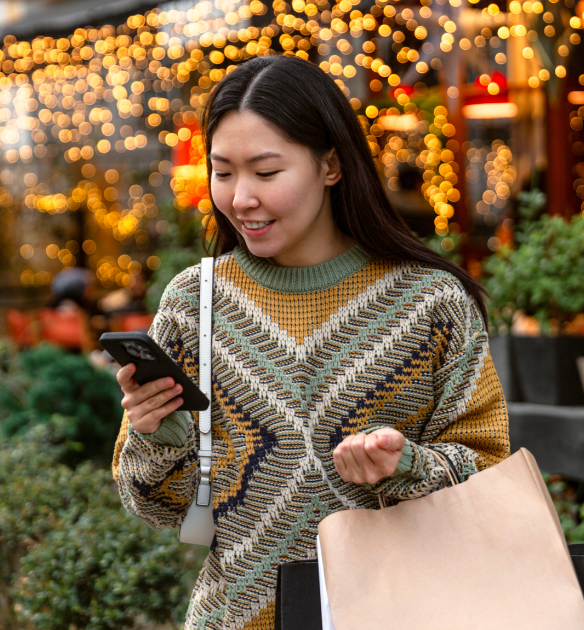The Always-On Luxury Shopper: Affiliate Marketing Strategies
The luxury shopping market continues to remain a key retail focal point despite economic headwinds. Our latest blog analyzes the luxury shopper, explores specific luxury shopping destinations, and provides tips and tricks on how best to leverage different affiliate marketing strategies to reach your ideal luxury consumer. Read the entire blog now to learn more!

The luxury shopping market is arguably one of the strongest markets in the retail industry and is predicted to hit $105.2 billion in 2023, according to Research and Market’s 2023 report, “Global Personal Luxury Goods Market”. Despite a downturn in the global economy and a rise in inflation, luxury goods remain a top priority for higher-end shoppers.
Rakuten Advertising conducted a survey of 15,000 US shoppers, delving into the high-stakes world of luxury shopping to reveal the latest insights for 2023. The luxury shopper is inherently unique; whether it be a window shopper looking for a good deal or a high-end shopper, they are largely unaffected by most economic tides.
We explored the shopping habits of the luxury goods consumer, uncovering how and where they shop, and comparing their in-store and online preferences for various luxury goods shopping destinations. With such a wide array of consumers, one thing remains true, affiliate marketing – especially content partners – can help reach the luxury consumer, wherever and however they are shopping. Our team of experts provided some top tips and tricks to help reach your ideal luxury shopper, wherever they’re shopping.
The many shopping destinations of the luxury consumer
Luxury goods is a unique area of retail where consumers can shop a multitude of different stores, price points, and avenues. Traditionally, luxury was reserved for the highest income brackets and was only available to shop in-house at luxury storefronts, but times have changed, and luxury goods have been made available through department stores, resale shops, and off-price retail stores. With the rise of affiliate marketing through loyalty, content, and popular cash-back sites, luxury has become even more accessible to the everyday shopper.
Let’s dive into the various shopping destinations and how luxury brands can leverage affiliate marketing to extend their reach to new and loyal customers.
Department stores
Department stores have become a mecca for luxury browsers as most major department stores, will house several major luxury brands within their main handbag. Here, the luxury shopper has all their options within reach, allowing them to touch and compare their next big purchase. Because of this, our survey skewed towards in-store shopping at department stores versus online when looking for luxury goods between the $1k and $20k price points.
From the experts:
Department stores market to a wide array of consumers but getting the majority of Millennial and Gen Z consumers to open their wallets for luxury items can be a hurdle for brands to overcome. One way to mitigate this is to offer buy-now-pay-later options at checkout, enabling payments to be split into individual payments, making that much-desired luxury item that much more affordable and in reach. Creating BNPL affiliate partnerships, and continuing to optimize them, allows luxury brands to gain new audiences and convert these new customers into loyal, quality customers.
- During peak campaign periods, integrate all key BNPL partners in your market, and secure paid coverage to increase full-price sales from a wider audience set.
Tip: brands can still integrate with BNPL partners through affiliate programs even if they don’t have those solutions integrated with the brand page checkout. Leaders in the BNPL field are paving the way for luxury brands, helping to expand their audience. Interested in learning more? Check out our Afterpay case study where they helped a leading luxury beauty brand grow their net new customers by 50%.
Off-price retail
Off-price retail stores are a favorite of many in 2023, as they allow shoppers to purchase luxury items at a significantly lower price. Off-price retailers offer past-season or lower-selling goods to shoppers who still want that luxury label name, just at a lower price point. They are particularly primed for affiliate marketing because of their discounting strategy and willingness to use traditional affiliate partners and promo sites.
As the market for off-price retail goods increases, so has the online presence of these stores, leading to an even split between in-store and online shopping preferences between the $5k and $20k price points. However, shoppers who spend more than $20k tend to shop more online, partially because they are finding higher price point luxury goods in their favorite off-retail online shop.
Leveraging affiliate marketing has been a staple of off-price retail as these retailers have been quick to promote on coupon and reward sites and continue this momentum by incorporating other affiliate strategies like cashback and influencers to give their online stores a much-deserved boost.
From the experts:
If you’re looking to maximize marketing dollars during key brand promotions or peak shopping periods, consider aligning affiliate placements with top-of-funnel sources, such as influencers or content partners, and bottom-of-the-funnel sources, including cash back or coupon partners.
- For your influencer and content partners, securing paid coverage or increasing commission rates to incentivize organic exposure during promotional periods can increase awareness and attract new audiences.
- For your cashback and coupon partners, securing paid coverage with elevated cashback rates during promotional periods can increase conversion rates and help secure buyers.
Luxury brand-owned stores
Nothing beats the in-store experience of shopping in a luxury store, from the elevated service to the product customization, in-store shopping is the clear favorite when shopping at a luxury brand store. The online experience doesn’t quite match up to the in-store experience, but with the implementation of affiliate marketing strategies, we can help close the gap.
While luxury brand-owned stores tend to shy away from discounts and coupons, other strategies can be utilized to boost online shopping. Partnering with online and in-store card-linked offer partners (aka CLO) can be an excellent way to bring in new customers, both online and in-store, without tarnishing the brand name.
From the experts:
Implementing partnerships with online and in-store CLO partners helps to acquire new, quality customers from reputable credit-card networks. Luxury customers view this cash-back strategy as a perk from their credit-card network rather than a discounting brand strategy, thus engaging new customers while maintaining a full-price brand image.
- Day-to-day shopping: Align on an “always-on” cash back rate, this will incentivize customers to activate cash back for your brand through the banking app. Then, they’ll earn cash back when they use that card to purchase your brand, either online or in-store.
- Promotional periods: Elevate card-linked offer cash-back rates during key brand promotional periods or holidays, incentivizing additional purchases with competitive cash-back rates.
Resale shops and the secondhand marketplace
Millennials and Gen-Z have paved the way for the luxury resale and secondhand marketplace, emphasizing the idea that shopping secondhand is cool. As the rise in resale has happened, so has the rise in online resale platforms that are exclusive to the web. Platforms reselling luxury goods are all exclusively online, meaning their shoppers must put their trust in these reseller brands to ensure authenticity and quality.
Despite this, consumers are spending their hard-earned money on secondhand luxury items from these sites, as there is a nearly equal split between in-store and online shopping between the $5k and $20k price points. Incorporating influencer marketing is one of the strongest affiliate strategies that can be used for the resale marketplace, as many Millennial and Gen Z shoppers frequent both social platforms and secondhand sites.
From the experts:
To promote your secondhand wares, consider incentivizing your content and influencer partners to support secondhand items by increasing the commission on those specific products. The competitive commission rates will incentivize more content and influencer partners to cover your brand, without paying a flat fee for coverage.
- During key full-price periods (February-April and August-October) secure influencer campaigns to promote and style secondhand items. Give your campaign a boost by securing paid coverage with product advertising partners to attract customers at multiple stops on the affiliate consumer journey.
Multi-brand luxury retailers
A popular alternative to department stores for the luxury shopper is a multi-brand luxury retailer, . These retailers offer a multitude of different luxury brands and often offer exclusive product launches and drops to differentiate from more traditional luxury retailers. Most multi-brand luxury retailers have online-only presences with no physical storefronts, so most luxury consumers will spend their shopping dollars online.
As these retailers navigate an online-only approach, utilizing affiliate marketing in an already existing marketing mix can be the key to capturing the market, especially as these retailers don’t have the added benefit of an in-person shopping experience. Partnering with influencers and product advertising sites (such as ShopStyle and Lyst) are excellent options for new product or brand launches, and leveraging cashback and loyalty sites can help brands differentiate from other online luxury retailers.
From the experts:
Consistent optimization with both influencers and product advertising partners can make a multi-brand retailer stand out amongst competitors and ongoing exposure can ensure customers purchase products from your site over competitors that may carry the same product.
- For your influencers, ensure you have consistent influencer campaigns for an “always-on” brand-awareness play, ensuring your brand is frequently highlighted across key social media platforms.
- For your Product Advertising Partners, the highest performing strategy is to keep long-term, top-of-market commission rates, these will work to increase your brand’s product algorithm ranking, thus enabling your products to appear above competitor products.
- During key campaign launches, secure paid coverage with product advertising partners in newsletters, homepage features, etc., to increase full-price purchases, and differentiate your brand against competitors.
The luxury shopper has a wide array of shopping options when looking to find their next luxury good, but tapping into where and how your ideal customer shops can help decide what strategies to put your high-value marketing dollars behind. For additional insights into the different affiliate shoppers, check out our latest series!
Expert insights were provided in collaboration with Danae Luetkehans, Client Services Manager.


